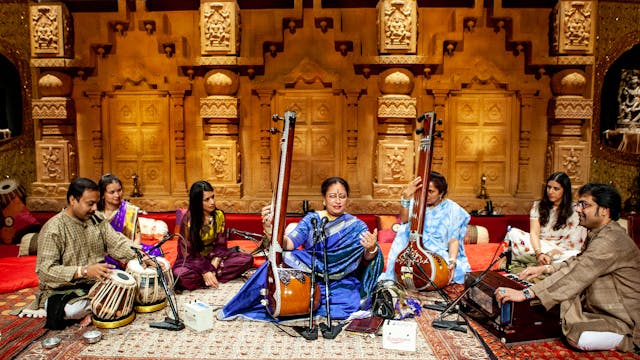Indrani Mukherjee | Bhairav
Devotional
•
4m 57s
Shot and recorded live in Kolkata at the 300-year-old heritage property, Bawali Rajbari.
Musician:
- Indrani Mukherjee (vocal)
Raag Bhairav; Thaat: Bhairav; Samay: Morning
In the Hindu pantheon of gods, Bhairav is another name for Lord Shiva – the temperamental deity of unprecedented destruction. Shiva is an embodiment of spunk, reserve, might and dramatic fortitude. In addition to these traits, the raga Bhairav is anchored upon undercurrents of desolation and deep pathos.
Indrani Mukherjee encapsulates vignettes of Bhairav in this beautiful lakshangeet composed by her guru, the distinguished scholar, composer, vocalist and teacher, Pandit Ramashreya Jha (1928-2009). The term ‘lakshangeet’ literally translates to ‘song with indications’. A lakshangeet indicates the taxonomy of a raga in its lyrics. Details like the jati (number of notes used), vadi swar (dominant note), samvadi swar (sub-dominant note), chalan (gait), samay (time of performance) are all contained in a poetic flair in the lyrics of the lakshangeet.
A lakshangeet also mentions the name of its composer. In this song, the name ‘Ramrang’ surfaces towards the end. It was the nom-de-plume used by Pandit Jha throughout his life. As a progressive and succinct thinker and writer, he has meticulously mentioned that Bhairav is one of the primary ragas that ought to be taught to beginners.
Mukherjee’s extraordinary timbre and succinct articulation is a result of years of training and deep research in Hindustani classical music. Her emphasis upon lyrics and enunciation sets her music apart as inspirational and compelling. She has trained under Late Pandit Arun Bhaduri (1943-2018) in Kolkata and then under Pandit Ramashreya Jha in Allahabad. She has learned thumri from Vidushi Purnima Choudhury (1946-2013). Her evolution to the present is strongly influenced by Vidushi Manju Sundaram under whom, she has been polishing her skills for years now.
One of the oldest ragas associated with early morning sadhana or riyaaz, supposedly Bhairav’s persona is difficult to please. It is derived from Bhairav thaat. It is a sampurna jati raga that uses all notes in both its ascent and descent. The vadi swar or dominant note is komal Dha (flat 6th) and the samvadi swar or sub-dominant note is komal Re (flat 2nd). Except these two flat swars, rest of the notes are shuddh or pure. Its arohana and avarohana are as follows:
S r G M P d NS’
S’ N d P M G r S
Its key phrases may be structured as follows: S r G M, G M r S, N.d.NS, G M d d P, G M r S
The word Bhairav (synonymous to Rudra or angry Shiva) suggests an aggressive persona. The aandolit (oscillating) komal Re and Dha give this raga a very heavy gait. Its intrinsic mood is powerful piety. There are many other popular ragas with Bhairav-ang such as Ahir Bhairav, Nat Bhairav, Bairaagi Bhairav etc.
Up Next in Devotional
-
Harikumar Sivan | Ram Bhajan
Recorded at Darbar Festival 2007, on 11th April, at the Curve Theatre, Leicester.
Musicians:
- Harikumar Sivan (7 string violin)
- Neyveli Venkatesh (mridangam)
- RN Prakash (ghatam)Bhajan, ‘Raghupati Raghava Raja Ram’ composed by Pandit Vishnu Digambar Paluskar (1872-1931)
Harikumar Sivan pa...
-
Parveen Sultana | Durga Bhajan Bhairavi
Recorded at Darbar Festival 2007, at the Phoenix Theatre in Leicester.
Musicians:
- Begum Parveen Sultana (Patiala gharana)
- Partha Sarathi Mukherjee (tabla)
- Chiranjib Chakraborty (harmonium)
- Nina Burmi (tanpura)
- Ranjana Ghatak (tanpura)
- Debipriya Das (support)Music piece: Bhavaani Da...
-
Parveen Sultana | Sai Raam Sumiran Karo
Recorded at Darbar Festival 2007, on 15th April, at the Phoenix Theatre, Leicester
Musicians:
- Begum Parveen Sultana (Patiala gharana)
- Partha Sarathi Mukherjee (tabla)
- Chiranjib Chakraborty (harmonium)
- Nina Burmi (tanpura)
- Gunwant Dhadyalla (tanpura)
- Debipriya Das (support)
- Ranjana ...



